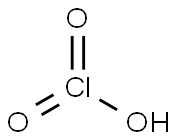
CHLORIC ACID
- русский язык имя
- английское имяCHLORIC ACID
- CAS №7790-93-4
- CBNumberCB0497587
- ФормулаClHO3
- мольный вес84.46
- EINECS232-233-0
- номер MDLMFCD00152974
- файл Mol7790-93-4.mol
| Температура плавления | <-20℃ [CRC10] |
| Температура кипения | >100 °C |
| плотность | 1.2 g/mL at 25 °C |
| растворимость | very soluble in H2O |
| цвет | exists only in aqueous solution |
| Растворимость в воде | very soluble H2O [CRC10] |
| Мерк | 13,2109 |
| Справочник по базе данных CAS | 7790-93-4 |
| FDA UNII | Z0V9L75H3K |
| Система регистрации веществ EPA | Chloric acid (7790-93-4) |
| Коды опасности | O,C |
| Заявления о рисках | 8-34 |
| Заявления о безопасности | 17-26-36/37/39-45 |
| РИДАДР | 2626 |
| Класс опасности | 5.1 |
| Группа упаковки | II |
рисовальное письмо(GHS)
-
рисовальное письмо(GHS)


-
сигнальный язык
опасность
-
вредная бумага
H314:При попадании на кожу и в глаза вызывает химические ожоги.
H271:Сильный окислитель; может вызвать возгорание или взрыв.
-
оператор предупредительных мер
P210:Беречь от тепла, горячих поверхностей, искр, открытого огня и других источников воспламенения. Не курить.
P220:Не допускать соприкосновения с одеждой и другими горючими материалами.
P260:Не вдыхать газ/ пары/ пыль/ аэрозоли/ дым/ туман.
P264:После работы тщательно вымыть кожу.
P280:Использовать перчатки/ средства защиты глаз/ лица.
P283:Пользоваться огнестойкой или огнезащитной одеждой.
P301+P330+P331:ПРИ ПРОГЛАТЫВАНИИ: Прополоскать рот. Не вызывать рвоту!
P303+P361+P353:ПРИ ПОПАДАНИИ НА КОЖУ (или волосы): Снять/удалить немедленно всю загрязненную одежду. Промыть кожу водой.
P304+P340:ПРИ ВДЫХАНИИ: Свежий воздух, покой.
P305+P351+P338:ПРИ ПОПАДАНИИ В ГЛАЗА: Осторожно промыть глаза водой в течение нескольких минут. Снять контактные линзы, если Вы ими пользуетесь и если это легко сделать. Продолжить промывание глаз.
P306+P360:ПРИ ПОПАДАНИИ НА ОДЕЖДУ: Прежде чем снять ее, немедленно промыть загрязненную одежду и кожу большим количеством воды.
P310:Немедленно обратиться за медицинской помощью.
P363:Перед повторным использованием выстирать загрязненную одежду.
P370+P378:При пожаре тушить сухим песком, сухим химическим порошком или спиртостойкой пеной.
P371+P380+P375:При масштабном возгорании с участием больших количеств продукта покинуть опасную зону. Тушить с расстояния из-за опасности взрыва.
P405:Хранить в недоступном для посторонних месте.
P501:Удалить содержимое/ контейнер на утвержденных станциях утилизации отходов.
CHLORIC ACID химические свойства, назначение, производство
Описание
Chloric acid, HClO3, is an oxoacid of chloride, and the formal precursor of chlorate salts. It is a strong acid (pKa=-1) and a strong oxidizing agent. It is stable in cold aqueous solution up to a concentration of approximately 30%, and solution of up to 40% can be prepared by careful evaporation under reduced pressure. Above these concentrations, and on warming, chloric acid solutions decompose to give a variety of products, for example:8HClO3→4HClO4+2H2O+2Cl2+3O2
Note that it disproportionates into perchloric acid in which the chlorine atom has a+7 oxidation state and also the zero oxidation state of chlorine gas (an oxidation–reduction reaction). Thus, under the proper conditions, it can also be used to make perchloric acid.
3HClO3→HClO4+H2O+2ClO2
Химические свойства
can occur only in an aqueous solution; oxidizing agent; preparation: reaction between H2SO4 and barium chlorate; used as a catalyst in the polymerization of acrylonitrile, as an oxidizing agent [MER06] [HAW93]Использование
Oxidizing agent; with H2SO3 as catalyst in acrylonitrile polymerization.Общее описание
CHLORIC ACID is a colorless liquid. CHLORIC ACID will accelerate the burning of combustible materials and can ignite most on contact. CHLORIC ACID is corrosive to metals and tissue. CHLORIC ACID is used as a reagent in chemical analysis and to make other chemicals.Реакции воздуха и воды
Water soluble.Профиль реактивности
Self-reactive. Concentrations of CHLORIC ACID above 40% decompose [Mellor 2 Supp. 1:576 1956]. Antimony sulfide and concentrated solutions of CHLORIC ACID react with incandescence [Mellor Supp. II Part I:584 1956]. Arsenic sulfide and concentrated solutions of CHLORIC ACID react with incandescence . Reacts with vigor even explodes with other metal sulfides, i.e. copper sulfide [Mellor Supp. II Part I:584 1956]. In contact with oxidizable materials, including ammonia, reactions can be extremely violent. Filter paper ignites after soaking in CHLORIC ACID, [Mellor, 1946, Vol. 2, 310]. Explosions have been recorded by mixtures of CHLORIC ACID solution with metals such as: antimony, bismuth, and iron. This is due to the formation of explosive compounds including hydrogen.Опасность
Toxic by ingestion and inhalation. Strong oxidizer, ignites organic materials on contact.Угроза здоровью
Inhalation, ingestion or contact (skin, eyes) with vapors or substance may cause severe injury, burns or death. Fire may produce irritating, corrosive and/or toxic gases. Runoff from fire control or dilution water may cause pollution.Пожароопасность
These substances will accelerate burning when involved in a fire. Some may decompose explosively when heated or involved in a fire. May explode from heat or contamination. Some will react explosively with hydrocarbons (fuels). May ignite combustibles (wood, paper, oil, clothing, etc.). Containers may explode when heated. Runoff may create fire or explosion hazard.Профиль безопасности
A poison. A strong irritant by ingestion and inhalation. Dangerous fire hazard; ignites organic matter upon contact. A very powerful oxidizing agent. Violent or explosive reaction with oxidlzable materials. Aqueous solutions decompose explosively during evaporation. Solutions greater than 40% are unstable. Reacts violently with NH3, Sb, Sb2S3, AsS3, Bi, CuS, PHI4+ SnS2, SnS. Reaction with cellulose causes ignition after a delay period. Dangerous reaction with metal sulfides and metal chlorides (e.g., incandescent reaction with antimony trisulfide, arsenic trisulfide, tin(lI)sulfide, tin(Iv> sulfide, explosion on contact with copper sulfide). Reaction with metals (e.g., antimony, bismuth, iron) forms explosive products. When heated to decomposition it emits toxic fumes of Cl-. See also CHLORATES and CHLORINE.CHLORIC ACID запасные части и сырье
запасной предмет
1of4
CHLORIC ACID поставщик
| поставщик | телефон | страна | номенклатура продукции | благоприятные условия |
|---|---|---|---|---|
| 18871490254 | CHINA | 28180 | 58 | |
| 86-13657291602 | CHINA | 22968 | 58 | |
| +86-023-6139-8061 +86-86-13650506873 |
China | 39916 | 58 | |
| +86-029-89586680 +86-18192503167 |
China | 8840 | 58 | |
| 0751-2815987 13927875076 |
China | 9977 | 58 | |
| 17691182729 18161915376 |
China | 10011 | 58 |